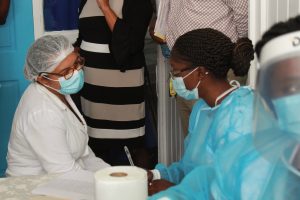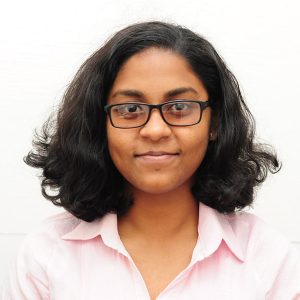– GPHC Pharmacist recounts experience with first dose of COVID-19 vaccine
By Vishani Ragobeer
AS a frontline worker exposed daily to potential and positively infected COVID-19 patients, signing up for the first set of COVID-19 vaccine was almost a ‘no-brainer’ for pharmacist at the Georgetown Public Hospital Corporation (GPHC), Brinnet Bernarai. What she didn’t expect was that she would have been the first person in the entire country to do so.
On Wednesday, February 10, Barbados donated 3,000 doses of the Oxford-Astrazeneca vaccine to Guyana; that Caribbean country secured 100,000 doses of the vaccine from India, as part of the South-Asian country’s Vaccine Maitri (friendship) initiative. And, by Thursday, Guyana was prepared enough to begin the rollout of the vaccines.
Since the Oxford-Astrazeneca vaccine is given in two doses, 1,500 persons would receive the jab from the donated batch. And, as part of the Ministry of Health’s vaccination rollout plan, frontline health workers were first in line to get those jabs.
Bernarai was one of those frontline health workers; at the GPHC, she works in the area setup for triage at the East Street side of the hospital. Here, every patient and visitor are screened as part of efforts to mitigate the spread of the virus into the hospital.
The ‘East Street’ triage area is also where the hospital’s pharmacy is located and Bernarai is often the nexus between patients who need their medicine (and the correct dosage, at that!) and the pharmacy.
“I found myself in contact with a lot of positive patients and so, it was said that the frontline workers would get the vaccine, especially those who work with positive patients or suspected COVID patients. I just said I would take it,” Bernardai told the Sunday Chronicle during an exclusive interview, recently.
Previously, this newspaper was told that the various Heads of Departments at the hospital were asked to submit a list of health workers who were willing to take the vaccine, as the vaccination is not compulsory. And, this is particularly important for those departments that were directly involved with the treating and interacting with COVID-19 patients.

A colleague of Bernarai, a young doctor also working in the triage area, was expected to be the first Guyanese, and the first local frontline worker to be vaccinated. But he became infected with COVID-19 before and therefore, could not receive the vaccine. That means, the ‘front-of-the-line’ spot was vacant.
“It was a surprise to me when I got there, and then they said that I’m the first person. It was a shock and surprise… I didn’t know because I expected the doctor first to get the shot,” the pharmacist recalled.
Soon after 09:00h on that Wednesday, the vaccine carriers, which allowed the vaccines to be stored at an adequately cold temperature, were brought to the vaccination room at the GPHC. Bernarai was given a vaccination card, which is particularly important as she is required to take a second dose of the vaccine after about eight to twelve weeks’ time, as suggested by the World Health Organisation (WHO).
As she walked into the room, which was, by the way, filled with eager health officials and members of the media, she was provided with basic information on the vaccine and what potential side effects she could experience. Subsequently, the vaccine dose was taken out of the carrier, inserted into the syringe and finally, inserted into Bernarai’s arm.
“When they told me I was ready, I was nervous because of the needle but then after I got the shot, it wasn’t that painful,” she related.
As part of the standard protocols instituted, Bernarai was required to sit down for 15 to 20 minutes. During that time, she would be monitored for any adverse reactions or side-effects to the vaccine. Common side-effects include redness and/or soreness at the site of the injection. Fortunately, she did not experience any concerning side-effects and was able to return to her duties.
Later that night, however, she began experiencing some side-effects; she had a mild fever and a headache. By morning, however, those side-effects had subsided and she said she was ready for another day of work on the frontlines.
“I feel very honoured to inspire people also to get their vaccine in this pandemic and not to be afraid. It’s a good thing and I think people should get the vaccine,” the pharmacist highlighted.
For her, personally, this vaccine brings a sense of relief. Though frontline workers are seen as some of the heroes of the pandemic thus far, their jobs are not the easiest. Exacerbating the risk of exposure to the virus, these workers also have to contend with those individuals who do not believe that COVID-19 is something they should be concerned with.
“That’s terrifying… when you’re trying to help them, you’re putting your life on the line, and they don’t want to listen” Bernarai said, commenting on persons’ nonchalance or sometimes, outright aversion to following the myriad of COVID-19 guidelines in place.
While vaccines may offer some amount of protection to health workers on the frontline, admittedly, there are still many uncertainties. There are concerns over how long the protection offered may last and also, whether they will be effective in protecting against the new and emerging variants of COVID-19. Though the technology used to develop these vaccines has been around for a number of years, and each of the vaccines went through the requisite clinical trials to ensure safety and efficacy, concerns over the short time in which these vaccines were developed linger.
These concerns are not unique to Guyana. In fact, the WHO noted that vaccine hesitancy — which is a delay in the acceptance or outright refusal of vaccines despite the availability of vaccination services — are a threat to global public health.
This sense of hesitancy, the WHO reported, may be driven by complacency, lack of confidence, fear and misinformation. On the same day Bernarai took her vaccine, Head of Internal Medicine at the GPHC, Dr. Mahendra Carpen also got his jab.
“I can understand the fear that people may have but when we look at the scientific evidence, the scientific scrutiny and everything that is presented, it’s very clear that the benefits outweigh the risk…. and that is what we look for in every medication, in every new medical device,” Dr Carpen told this newspaper.
Bernarai, too, was of the opinion that widespread vaccination would help the population exit the pandemic.
“The vaccine is a very good thing and as it was developed, it went through all the trials before it was cleared and given to us…I think I’m grateful that we have the vaccine, as a third world country, we have the vaccine and we will be okay,” she emphasised.
Minister of Health, Dr. Frank Anthony, recently highlighted that Guyana will be delaying the time between the first and second doses of the Oxford-AstraZeneca vaccine from three weeks to between eight to twelve weeks.
This Oxford-AstraZeneca vaccine, which is manufactured in India by the Serum Institute, has an efficacy of 62 per cent, while it offers 100 per cent protection against the severe form of COVID-19, hospitalisation and death in a primary analysis of Phase III clinical trials. However, studies carried out in a smaller subgroup reported that the vaccine is 90 per cent efficacious, with a lower dose than the required two doses.
Now, according to a newer study from the Oxford University that is under review at the Lancet, a single standard dose of the vaccine provided 76 percent protection (or efficacy) overall against symptomatic COVID-19 in the first 90 days (about twelve weeks). Then, vaccine efficacy reached 82.4 per cent after a second dose in those persons with a dosing interval of about 12 weeks.



.jpg)








